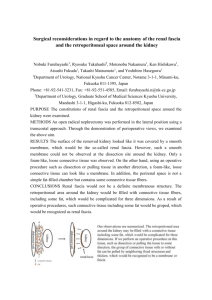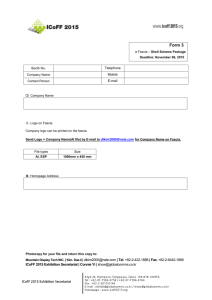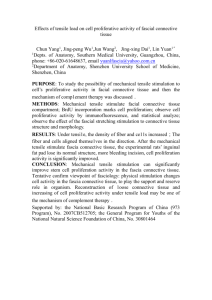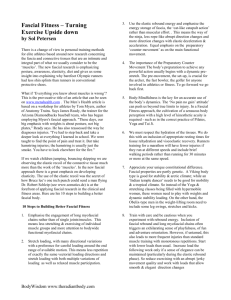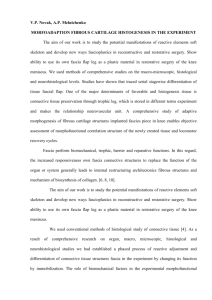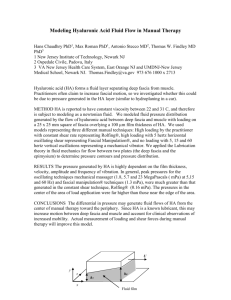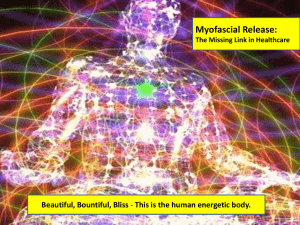The Role of Fascia in Manipulative Treatment of Soft Tissues
advertisement
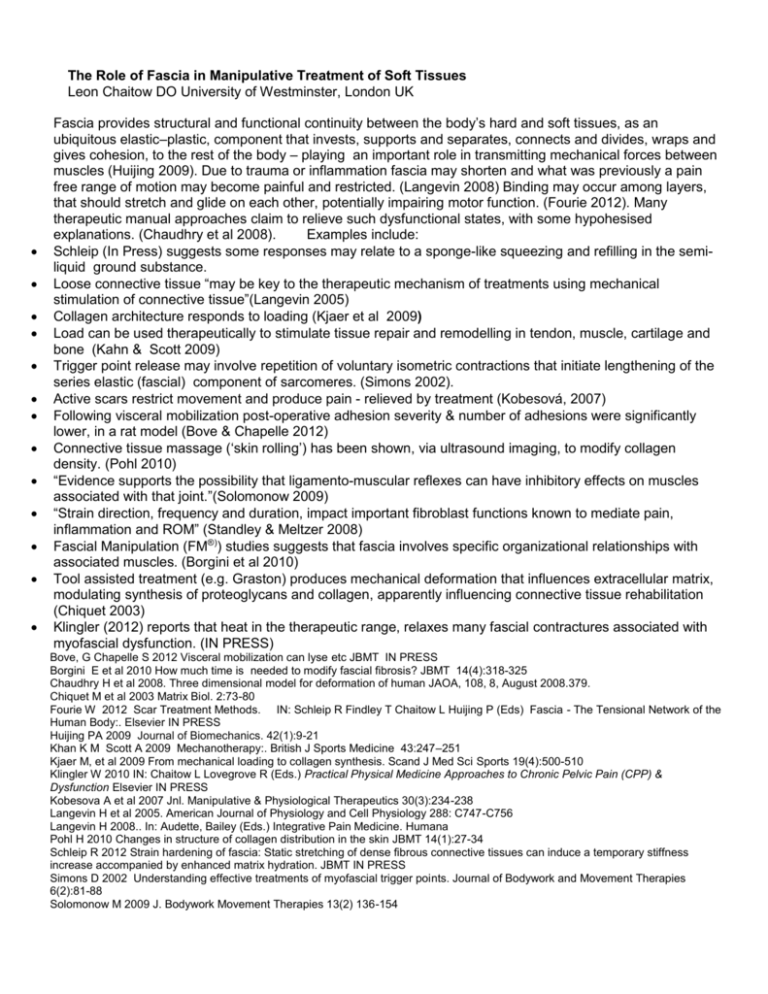
The Role of Fascia in Manipulative Treatment of Soft Tissues Leon Chaitow DO University of Westminster, London UK Fascia provides structural and functional continuity between the body’s hard and soft tissues, as an ubiquitous elastic–plastic, component that invests, supports and separates, connects and divides, wraps and gives cohesion, to the rest of the body – playing an important role in transmitting mechanical forces between muscles (Huijing 2009). Due to trauma or inflammation fascia may shorten and what was previously a pain free range of motion may become painful and restricted. (Langevin 2008) Binding may occur among layers, that should stretch and glide on each other, potentially impairing motor function. (Fourie 2012). Many therapeutic manual approaches claim to relieve such dysfunctional states, with some hypohesised explanations. (Chaudhry et al 2008). Examples include: Schleip (In Press) suggests some responses may relate to a sponge-like squeezing and refilling in the semiliquid ground substance. Loose connective tissue “may be key to the therapeutic mechanism of treatments using mechanical stimulation of connective tissue”(Langevin 2005) Collagen architecture responds to loading (Kjaer et al 2009) Load can be used therapeutically to stimulate tissue repair and remodelling in tendon, muscle, cartilage and bone (Kahn & Scott 2009) Trigger point release may involve repetition of voluntary isometric contractions that initiate lengthening of the series elastic (fascial) component of sarcomeres. (Simons 2002). Active scars restrict movement and produce pain - relieved by treatment (Kobesová, 2007) Following visceral mobilization post-operative adhesion severity & number of adhesions were significantly lower, in a rat model (Bove & Chapelle 2012) Connective tissue massage (‘skin rolling’) has been shown, via ultrasound imaging, to modify collagen density. (Pohl 2010) “Evidence supports the possibility that ligamento-muscular reflexes can have inhibitory effects on muscles associated with that joint.”(Solomonow 2009) “Strain direction, frequency and duration, impact important fibroblast functions known to mediate pain, inflammation and ROM” (Standley & Meltzer 2008) Fascial Manipulation (FM®)) studies suggests that fascia involves specific organizational relationships with associated muscles. (Borgini et al 2010) Tool assisted treatment (e.g. Graston) produces mechanical deformation that influences extracellular matrix, modulating synthesis of proteoglycans and collagen, apparently influencing connective tissue rehabilitation (Chiquet 2003) Klingler (2012) reports that heat in the therapeutic range, relaxes many fascial contractures associated with myofascial dysfunction. (IN PRESS) Bove, G Chapelle S 2012 Visceral mobilization can lyse etc JBMT IN PRESS Borgini E et al 2010 How much time is needed to modify fascial fibrosis? JBMT 14(4):318-325 Chaudhry H et al 2008. Three dimensional model for deformation of human JAOA, 108, 8, August 2008.379. Chiquet M et al 2003 Matrix Biol. 2:73-80 Fourie W 2012 Scar Treatment Methods. IN: Schleip R Findley T Chaitow L Huijing P (Eds) Fascia - The Tensional Network of the Human Body:. Elsevier IN PRESS Huijing PA 2009 Journal of Biomechanics. 42(1):9-21 Khan K M Scott A 2009 Mechanotherapy:. British J Sports Medicine 43:247–251 Kjaer M, et al 2009 From mechanical loading to collagen synthesis. Scand J Med Sci Sports 19(4):500-510 Klingler W 2010 IN: Chaitow L Lovegrove R (Eds.) Practical Physical Medicine Approaches to Chronic Pelvic Pain (CPP) & Dysfunction Elsevier IN PRESS Kobesova A et al 2007 Jnl. Manipulative & Physiological Therapeutics 30(3):234-238 Langevin H et al 2005. American Journal of Physiology and Cell Physiology 288: C747-C756 Langevin H 2008.. In: Audette, Bailey (Eds.) Integrative Pain Medicine. Humana Pohl H 2010 Changes in structure of collagen distribution in the skin JBMT 14(1):27-34 Schleip R 2012 Strain hardening of fascia: Static stretching of dense fibrous connective tissues can induce a temporary stiffness increase accompanied by enhanced matrix hydration. JBMT IN PRESS Simons D 2002 Understanding effective treatments of myofascial trigger points. Journal of Bodywork and Movement Therapies 6(2):81-88 Solomonow M 2009 J. Bodywork Movement Therapies 13(2) 136-154 Standley P Meltzer K 2008 Effects of Repetitive Motion Strain (RMS) & Counter-Strain (CS), on fibroblast morphology and actin stress fiber architecture Jnl.Bodywork & Movement Therapies, 12(3):201-203


